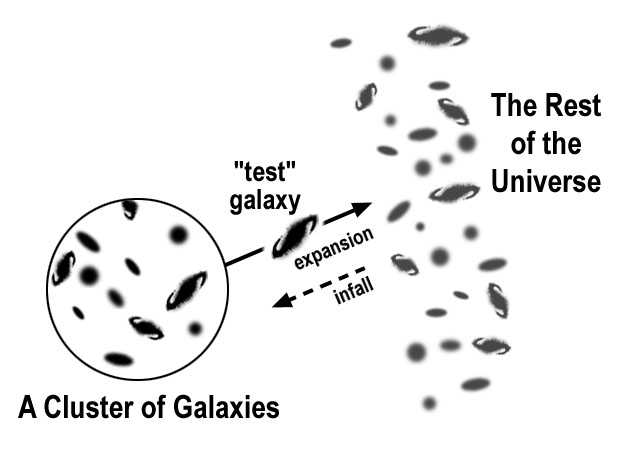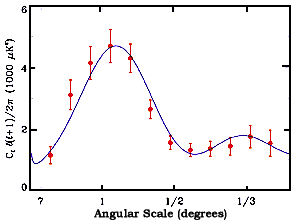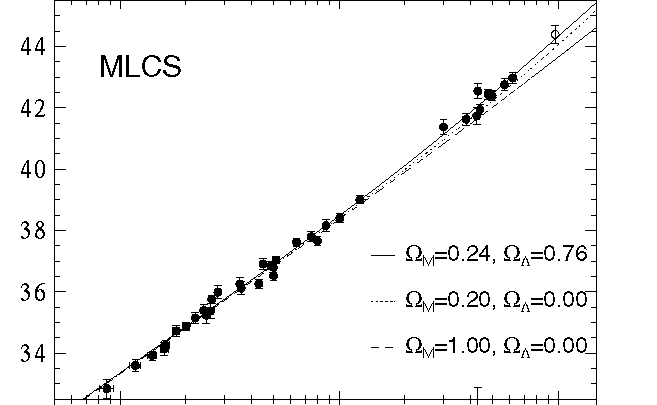Chapter 5. The Matter Dominated Universe: From Helium to Uranium
|
Structure Formation: Galaxies as Containers of Life
The image below is part of the Ultra Hubble Deep Field that was obtained in 2004 by the Hubble Space Telescope. In this image, which is just a tiny piece of the sky, we see thousands of galaxies of different colors, shapes and sizes.

For now, we should view galaxies as the basic mass structures that formed (somehow) in the Universe and these mass structures serve as the basic containers for large amounts of gas (hydrogen). When this hydrogen is collected and contained in one structure, the gas can cool and fragment and turn into stars. In turn, those stars will process the hydrogen gas into heavier and heavier elements through the process of nuclear fusion. Eventually planets and life will arise in these galaxies. Hence the formation of Galaxies after recombination, when matter can clump due to gravity, is really the first necessary step in the formation of Life.
Moreover, it is now well established that the formation of galaxies did not occur in an isolated manner. Where one galaxy formed, others seemed to have formed. This has lead to a very strong hierarchical clustering of galaxies as shown below:
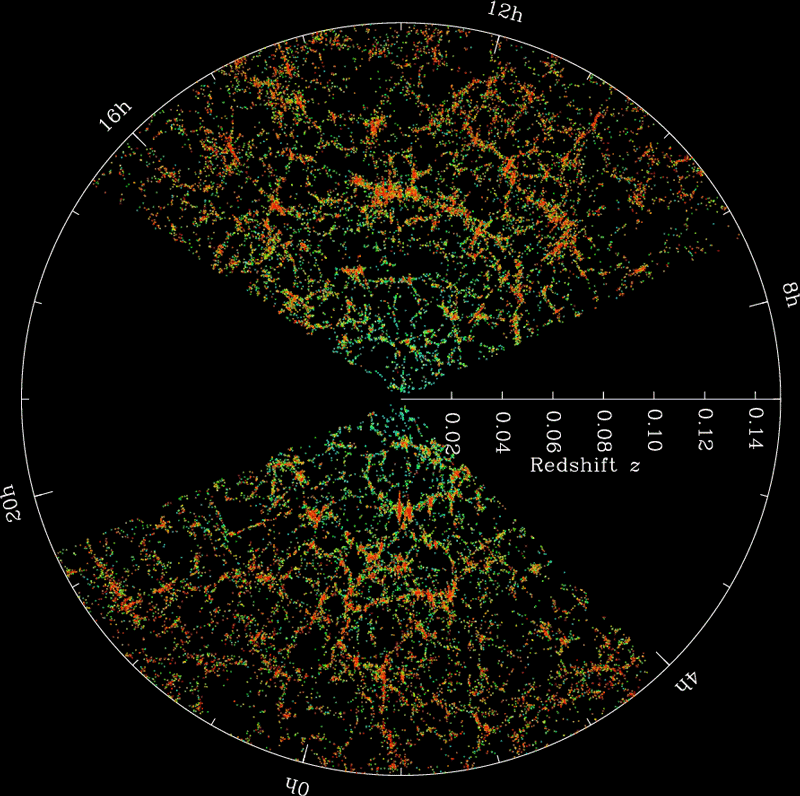
This map of the galaxy distrubution shows a highly filamentary structure in which galaxies are distributed on a complex and connected network. Within that network are large black regions, called voids, which are, you guessed, devoid of galaxies. The two large black wedges are just where our own Galaxy interferes with our view of distant galaxies and so no data exists in those regions. The complexity of the galaxy distribution is very hard to understand but current modelling of this structure suggests that the existence of dark matter is necessary condition to produce the observed complexity.
The Evidence for Dark Matter
Before discussing the relation between dark matter and structure formation, it is useful to summarize the various lines of evidence that suggests in must exist. Keep in mind that although it must exit, actually, we have not yet detected it. This should soften the word, "must". In this way, believe in dark matter is perhaps more faith based than evidence based. This is not an unsual situation for science, although the lay person is seldom exposed to this situation.
Objects which emit light, whether they are cigars, light bulbs, cows, stars or galaxies can be characterized by their emitted energy per unit mass. This is parameterized as the Mass to Luminosity ratio or M/L. For cosmological purposes, it is most convenient to express M/L in terms of solar masses and luminosities. For main sequence stars it can be shown that L is proportional to M3.5-4 . Thus, a 10 solar mass star star has M/L of approximately 0.001, a 1 solar mass star has M/L =1 and a 0.1 solar mass star has M/L of approximately 1000. The term "dark matter" refers to the the existence of objects which have extreme values for M/L.
In general, the evidence for dark matter is a result of analyzing the motions of test particles on some scale and seeing if there is enough mass that can be accounted for by the light emitting objects on that scale to produce the observed motion. If there is not enough light, then some other form of matter must be providing the mass. The first historical success of using perturbed motions to find matter was the discovery of Neptune in 1846 from the observed perturbations in the motion of Uranus. In the 20th century, a similar analysis of Neptune allowed for the discovery of Pluto in 1930. There is no evidence for dark matter in our Solar System.
Similarly, if one analyzes the motions of nearby stars around us to constrain the local mass density of our place in the disk of our Galaxy, there is no strong evidence for dark matter. But, a census of the mass in our neighborhood is interesting. The total mass density that has been inferred is approximately 0.18 solar masses per cubic parsec. Testing for the presence of dark matter in the solar neighborhood now becomes an accounting problem. The possible sources of this mass in the solar neighborhood are 1) luminous stars, 2) interstellar gas, 3) stellar remnants (mostly white dwarfs) and 4) dark matter. Observations indicate that approximately 0.1 solar masses per cubic parsec of mass density is in the form of luminous stars (including the thick disk component of our Galaxy). This implies additional mass not in the form of luminous stars but it can readily be accounted for. Approximately 0.05 solar masses per cubic parsec is in the form of gas (gas gets turned into stars, of course), and the remaining 0.03 solar masses per cubic parsec is in the form of white dwarfs (stellar evolutionary end points of low mass stars). Thus within our local area of the Galaxy, there is no evidence for dark matter.
However, on scales of galaxies and clusters of galaxies, there is ample evidence for dark matter. For individual galaxies, this evidence comes mostly from analysis of galaxy rotation curves. A rotation curve is a measurement of the orbital velocity of a star as a function of radius from the center of a galaxy. For instance, our Sun is orbiting our Galaxy at a velocity of 220 km/sec. The Earth is orbiting the sun at a velocity of 30 km/sec while Mars is orbiting at 24 km/sec. The reduced orbital velocity of Mars is because it feels less gravitational acceleration than the Earth because its farther away from the Sun and the Sun is effectively a gravitational point Mass which contains all of the mass of the Solar sytem. If galaxies had a mass distribution like the Solar system, then we would expect the orbits of stars that are more distant from the center of the galaxy to be less than stars that are closer. As shown below, this is not what is observed.
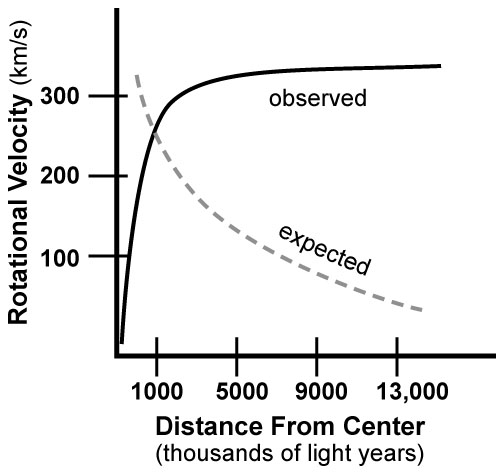
| Figure Schematic representation of the rotation curve of a galaxy. If most the mass of the galaxy is in the center, then one expects smaller rotational velocities with increasing distances from the center of the galaxy. This is shown in the dashed line and is not what is actually observed. Instead, rotation curves of the form depicted by the solid line are observed. The observation that the rotational velocity is constant after some radius implies that the mass of the galaxy must be in a greatly extended (relative to the light) distribution. |
In the figure below we show
a typical rotation curve for a real spiral galaxy. These data
clearly show a flat rotation curve.

| Figure 5.3 A rotation curve of a spiral galaxy. The center of the galaxy is at r = 0 and both halves of the galaxy rotation curve are shown here. The higher velocity side is rotating away from the observer and the lower velocity side would be rotating towards the observer. The galaxy quickly reaches its maximum rotational velocity at a relatively small radius and maintains that velocity out to the limits of the data. |
The existence of flat rotation curves of galaxies can only be explained if the mass of the galaxy is increasing in direct proportion to the radius. We can understand this by referring to the derivation of Kepler's Third Law that was done in Chapter 1. Newton was able to show that for an object in circular orbit, the orbital velocity is determined by the total mass enclosed within the radius. In equation form, this is given by

But why can't galaxy halos just be composed of stellar remnants? For instance, a galaxy halo that was composed of black holes would certainly be dark yet provide enough mass to account for the observed flat rotation curves. This can be ruled out by a very simple but powerful argument. A black hole is the endpoint evolution of a massive main sequence star. Thus, the object that is now the black hole wasn't always black. There was a period when it was producing light. Hence, if galaxy halos are now composed of black holes or other remnants, there would have been a time in the past when the halo was full of luminous stars. As we look out farther in distance we are looking back in time due to the finite speed of light. Hence, halos should be bright when galaxies are younger but observations of distant galaxies do not show any evidence for luminous halos as a function of look-back time. As a result we can rule out galactic halos as being composed of mostly stellar remnants.
Clusters of Galaxies

| Figure A typical cluster of galaxies. The individual members do not escape from the cluster as sufficient mass exists to prevent the expansion of the cluster. |
Clusters of galaxies represent a region of the Universe in which the mass density is sufficiently high that the expansion has been overcome. An example cluster is shown the Figure. This mass density serves to randomize the velocities of the cluster members as they assume some orbit about the center of the mass of the cluster. In fact, if our galaxy were located in a cluster, then measurements by Slipher and Hubble would have not so easily revealed universal expansion as some nearby galaxies would be moving towards us and some away from us since all the galaxies would be in this cluster. To detect universal expansion would have required observations of galaxies beyond the cluster and those galaxies would have been too faint to measure relative to the technology of the time.
If we simply measure the relative velocities of the galaxies we can infer the total mass of the cluster under the reasonable assumption that the cluster is gravitationally bound. A small complication enters in that one needs to know the exact shape of the cluster; a spherical cluster is different than one that is shaped like a pancake - but the general principal applies. That dynamical mass estimate can then be compared to the mass estimate based on counting the number of galaxies in the cluster and adding up all their light. When this is done, it is typically found that the luminous galaxies in the clusters can only provide 5-10% of the total mass required for the cluster to exist. Therfore, some form of dark matter pervades the cluster and provides most of the dynamical mass necessary to bind the cluster together, gravitationally.
Similarly, the dark matter distribution in clusters of galaxies can manifest itself through the gravitational lensing mechanism first proposed by Einstein. Because light is contrained to follow the curvature of the Universe then it can get distorted by that curvature. Thus, galaxies who lie behind a cluster with a lot of dark matter will have their optical appearance distorted by that cluster into a series of arcs and arclets as easily shown in this Hubble Space Telescope image:
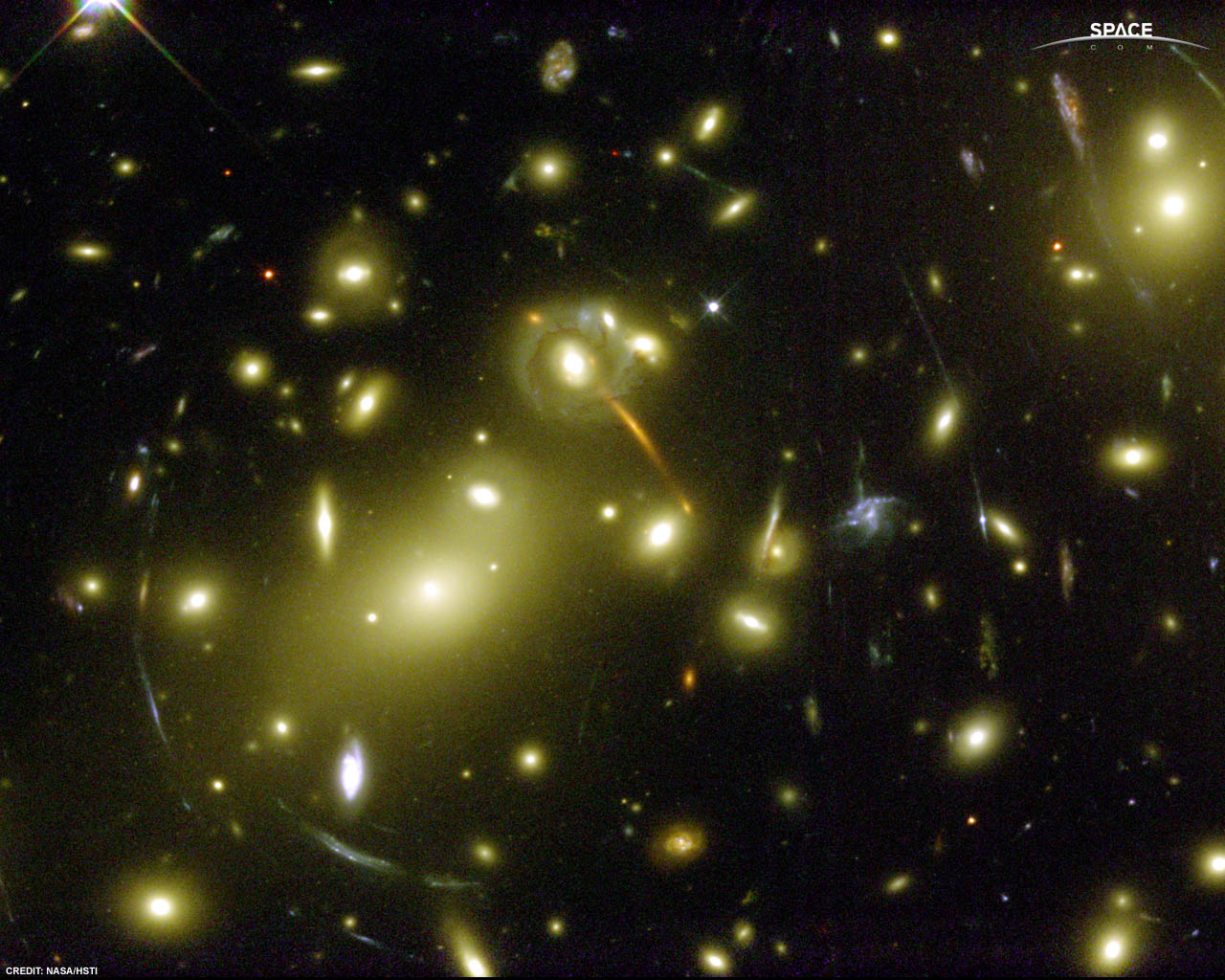
|
Figure The cluster Abell 2218.
The appearance of "arcs" in the image is a manifestation of the
distortion of the images of background galaxies by the lensing
mass of the cluster. |
The orientation
and degree of curvature of these features depends upon the cluster
mass distribution and the overall amount of mass. Again, when the
mass is inferred in this manner and compared to the luminous galaxies
in the cluster, a substantial mass discrepancy exists. When this
evidence is combined with the velocity data, there is
little doubt that in clusters of galaxies, a substantial amount of
dark matter must be present.
Possible Kinds of Dark Matter
In considering the kinds of dark matter there are two broad possibilities. Normal dark matter is composed of baryons and is referred to as baryonic dark matter. An important feature concerning baryonic dark matter is that it wasn't necessarily always dark. A stellar mass black hole is the prime example as it once was a star radiating energy. Exotic dark matter would be non-baryonic in nature and is most probably in the form of some strange particle, hitherto undetected. If the mass of the Universe is in the form of a particle (like WIMPS) then that will not be directly detected through telescopic observation, but rather in some high energy accelerator experiment on the Earth (like the Large Hadron Collider).Some candidate forms of dark matter are listed below:
- Bricks: A brick is an excellent candidate for dark matter
as it has very high M/L. Filling the Universe with bricks, however,
is not possible because bricks are made of heavy elements and would
have therefore required a lot of massive stars to exist previously
to make these heavy elements. This is not observed so
the Universe is not filled with bricks.
- Small Balls of Hydrogen. A Jupiter mass ball of hydrogen would
have high M/L in the optical bands. The mass of Jupiter is
approximately
0.001 solar masses and the required space density to have our mass
dominated by these objects would be around 10 Jupiters per cubic parsec.
This space density
only contributes 0.01 solar masses per cubic parsec of mass density in the
solar neighborhood. Hence, the survey of the distribution of mass in
the solar neighborhood discussed previously would be unable to rule
out the presence of this population. However, Jupiter balls would still radiate luminosity at infrared wavelengths. Observations with the Spitzer Space Telescope, which is an Infrared telescope, would have detected these balls if they dominated the mass of our Galaxy. These limits are so strong that very little of the total
mass of the galaxy can be in this form.
- Stellar remnants: Since the Galactic disk is not yet old
enough for white dwarfs to cool down to temperatures below a few hundred
degrees K
(and hence become invisible)
or neutron stars to slow down and cease being pulsars
(and hence become undetectable), the only viable high M/L
remnant that would escape local detection is stellar mass black holes.
As discussed before, while black holes are an excellent example of
dark matter, they used to be bright, massive stars and hence would have been
visible in the past. Moreover, since massive stars produce the bulk
of the heavy elements in the galaxy, then they leave behind a chemical
tracer of their existence. If the dark matter in our Galaxy is dominated
by a population of black hole remnants, then its heavy element content
should be much larger than is actually observed. This in fact
raises the general expectation that the production of baryonic dark
matter (in the form of stellar remnants) is directly related to
the chemical evolution of a galaxy. Galaxies with more heavy elements
in them should have more stellar remnants and more baryonic dark
matter. While there is some observational support for this, the amount
of heavy elements that would have been produced by a pre-existing
population that has now produced black hole remnants would be
sufficient to start an Interstellar gold rush. Hence, the mass of
our galaxy can't be dominated by black hole remnants either.
- Big Stellar Remnants: Globular Clusters are the oldest known
stars in our galaxy and may have been the first objects to form in
the Universe. However, Globular Clusters do show signs of chemical
enrichment. To account for this, theorists have postulated the
presence of a population of very massive stars (10,000 solar masses and
higher) that formed prior to the formation of globular clusters and
seeded the Universe with a few heavy elements. These very massive
objects (VMOs) could have coalesced together into a very large
stellar remnant, say a one million solar mass black hole.
There would only have to
be a million of these objects in our galaxy for the total mass to
be dominated by them. However, if this were the case we would expect
one of these objects to orbit through the galactic plane every 100
years and swallow up lots of gas and dust and have a very visible
manifestation. Hence, VMO remnants are not a likely candidate either.
- Quantum Black Holes: An
intersection between General Relativity and the precepts of
quantum mechanics allows for the existence of a very unusual particle -
a mini black hole. A mini black hole has a mass equivalent to that
of a large terrestrial mountain, about 1015 grams and a radius
of 10-13 cm. Such an object could only be created by tremendous
compressional forces which might have been present in the very
early Universe. As the radius of a mini black hole is like that of
a nucleon, it is a quantum mechanical system and energy can leak out.
As energy leaks out, mass is lost and the system shrinks which
accelerates the energy loss. Mini black holes are then destined to
"evaporate". The last stage of this evaporative process is
the sudden release of high energy photons (gamma rays). For a mass
of 1015 grams the evaporation time scale is 10 billion years.
Amazingly enough, a population of gamma ray bursters has been
detected in the last 15 years.
However, no one believes this population is
due to evaporating mini black holes.
- Non-baryonic dark Matter: This form of dark matter would be a particle,
like a neutrino or a WIMP (discussed earlier).
Furthermore, that dark matter must be distributed more smoothly than the light
and be distributed between the galaxies as well as in galaxies.
In this scenario, the Universe is a sea of non-baryonic dark matter
with little bits of baryonic material (e.g. galaxies) floating about
in it.
Non-baryonic dark matter comes in two basic forms: hot and
cold. Hot dark matter (HDM) means the particle is relatively light
so that when it was initially created in the early Universe it
moved near the speed of light. There is only one strong candidate for
HDM and that is a neutrino. In the late spring of 1998, new experimental
data on the mass of the neutrino was released. That data is very
discouraging in the cosmological context as the limits on the mass
are far below that required to make the neutrino a major mass
constituent of the Universe.
This leaves us with cold dark matter (CDM). CDM consists of weakly interacting massive particles (WIMPs) that are able to cool and clump together even at relatively high temperatures. This requires the rest mass of most CDM WIMPs to be extremely large. In fact, a typical WIMP would have about 1016 times the rest mass energy of a proton. This is a heavy particle! As discussed in Chapter 3, some WIMPs could have been created very early on through quantum fluctuations and if they did not immediately annihilate with their respective anti-WIMPS, could survive as the dominant relic mass today. The basic problem is that no particle physics experiment on the earth has uncovered any evidence for these WIMPs or any other form of CDM despite searching for more than 20 years. If CDM exists, we are thus quite ignorant about its form. Paradoxically, however, the existence of galaxies may in fact require some form of CDM
Structure Formation and the neccessity of CDM
The basic mechanism that we can understand for the formation of structure in the Universe is known as Gravitational Instability. Gravitational Instability works by a relatively simple principle - if there is some density enhancement in a matter field, then that density enhancement will sweep up material and continue to grow. The problem with this scenario occurs if there is no dark matter in the Universe. As discussed in Chapter 4, baryonic material in the Universe would be subject to strong radiation pressure and drag and would have a difficult time clumping. In fact, it's not clear if galaxy formation would even ever occur if only baryons exist. Hence, one of the best physical arguments for dark matter is the very existence of galaxies. Baryonic density fluctuations will likely not produce galaxies. To produce galaxies you need a heavy particle that is not effected by radiation pressure so it can clump and form density enhancements very early on (long before the epoch of decoupling). If this is correct, it means that galaxies are surrounded by dark matter halos which trapped baryonic gas (e.g. hydrogen) and turned it into stars. This also means that there should be some halos which didn't trap any baryonic material to eventually form a luminous galaxy and therefore should remain dark. Such dark galaxies have not yet been unambiguously detected, although there are candidates.The exact mechanism of how Gravitational Instability actually produced the complex patterns seen in galaxy clustering is unknown. This pattern of galaxy clustering is called large scale structure. When run inside a computer, a dark matter simulation of stucture formation among looks like the example below in which a rich network of filamentary structure is revealed. This provides good qualitative agreement with the actual galaxy distribution.

|
Figure 5.7 Large scale structure in a Dark Matter supercomputer simulation. Image
courtesy of the HPCC group at the University of Washington and George Lake. This
simulation shows a void filled Universe with much filamentary structure. Clusters of
galaxies appear to form at the intersections of voids.
|
However, there are two basic ways to produce a highly clustered Universe. The first mechanism makes extremely large objects formed first. This is known as the top-down scenario. These large objects have the mass of several galaxy clusters. Subsequent fragmentation of these very large regions into smaller regions then produced the hierarchical pattern we see today- galaxies in clusters, clusters within superclusters, etc. At the opposite extreme is the scenario which argues that sub-galactic size masses formed first. This is known as the bottom-up scenario. After these sub-galactic masses are formed, subsequent gravitational coalescence produce galaxies, which in turn gravitationally coalesce to produce clusters of galaxies.

|
A Hubble Space Telescope of
distant sub-galactic mass objects that appear to be coming together
to form a single galaxy.
|
Both the top-down and bottom-up scenarios can produce the same kind of large scale structure in the Universe so, even though the physics is much different in these scenarios, observations of the nearby Universe and its associated patterns of galaxy clustering can't really tell us which one occurred. The main difference between these two scenarios is that, in the top-down one we would expect to see clusters of galaxies very early on in the Universe where as in the bottom-up scenario we would expect to see galaxies before we would see them arranged in clusters. Therefore, if we can look farther and farther back in time, we may be able to observationally map out the correct time sequence.




